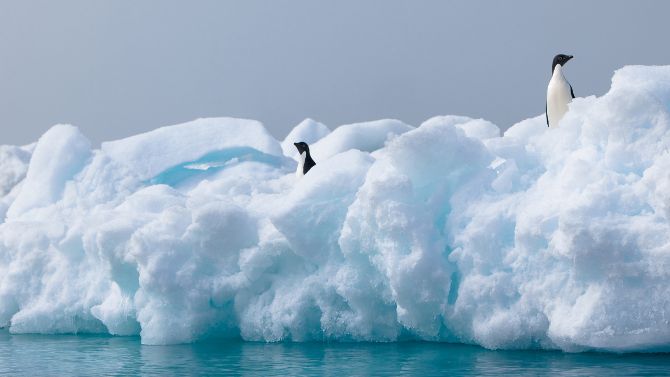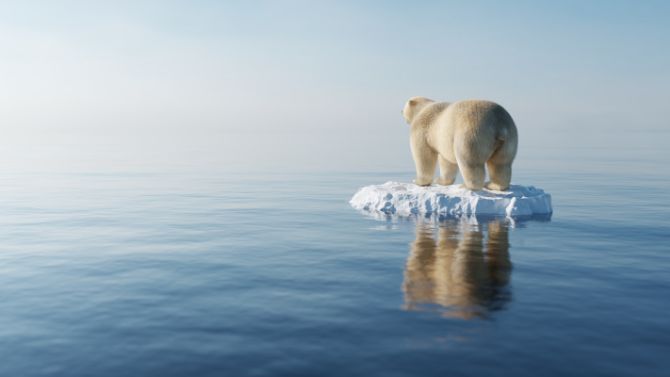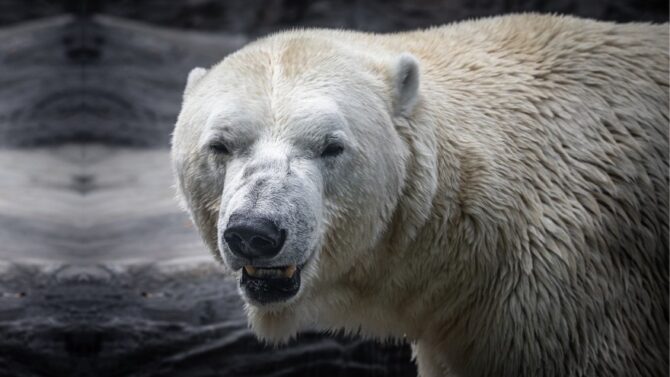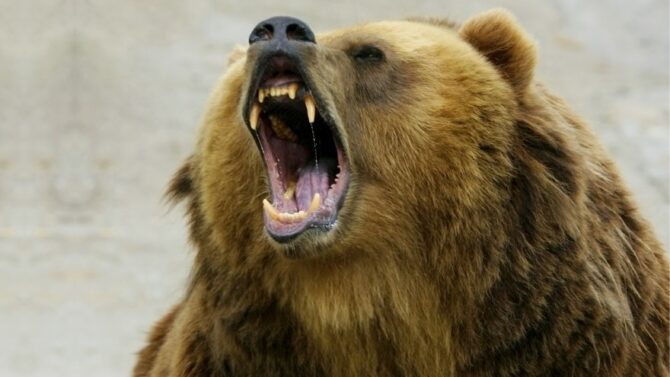Ever watched a cartoon where a polar bear and a penguin are hanging out together on an ice block? I did, and for the longest time, I believed they were next-door neighbors in the wild. It got me thinking, “Do polar bears eat penguins?” So, I explored the topic, and found out the true answer: No, polar bears do not eat penguins, and here is why.
Key Features of Polar Bears
Polar bears, known as Ursus maritimus, are native to the Arctic. These creatures have evolved to thrive in a cold environment and are apex predators.
Physical Characteristics
Polar bears are well-adapted to the freezing conditions of the Arctic. Their thick layer of blubber provides insulation, while their white fur camouflages them against the snow. With powerful limbs, they’re proficient swimmers, capable of covering large distances in search of food.
Their primary diet consists of seals, which they hunt using their sharp sense of smell and superior strength.
Habitat and Range

The Arctic is a vast expanse, encompassing the North Pole and surrounding regions. Sea ice plays a crucial role in the polar bear’s existence, acting as a platform for hunting and movement. As the ice retreats during warmer months, polar bears either roam the open waters or retreat to the coasts.
With climate change impacting their habitat, polar bears are facing challenges in finding food and maintaining their traditional territories.
Main Characteristics of Penguins
On the opposite end of the globe, penguins predominantly inhabit the Southern Hemisphere. These flightless birds are equally adept in icy conditions and are renowned for their unique waddle.
Types of Penguins
While many might envision penguins solely in snowy landscapes, there are various species, each adapted to its environment. The Emperor penguin, the largest of the species, calls Antarctica home. Meanwhile, the Galapagos penguin resides near the equator.
Different species have distinct diets. While some primarily eat krill, others feast on fish or squid. All penguins, however, are excellent swimmers and divers, using their strong flippers to propel themselves in the water.
Penguin Habitats

Penguins are found on every continent in the Southern Hemisphere. From the icy shores of Antarctica to the temperate beaches of New Zealand and South Africa, they’ve carved out niches in diverse ecosystems.
The harsh conditions of Antarctica support only a few species, such as the Emperor and Adelie penguins. Meanwhile, the warmer regions provide habitat for species like the African penguin and the Magellanic penguin.
Dietary Preferences and Predation Understanding the diet of both these animals gives more clarity to our main question.
Dietary Preferences
| Aspect | Polar Bears | Penguins |
|---|---|---|
| Predatory Nature | Apex predators in the Arctic, mainly hunt seals | Prey to various predators, both in water and on land |
| Primary Prey | Seals | Fish, krill, and other small marine creatures |
| Opportunistic Eaters | Can consume other animals or scavenged food when necessary | Opportunistically feed on small marine creatures, including fish and krill |
| Impact on Ecosystem | Maintain the balance of the Arctic ecosystem | Play a role in marine ecosystems as both prey and predator |
| Conservation Concerns | Vulnerable due to climate change and sea ice loss | Vulnerable due to habitat loss and introduced predators |
| Defense Mechanisms | Excellent swimmers; rely on hunting skills | Countershading coloration, safety in numbers, and agility in water |
| Habitat | Arctic regions, primarily on sea ice | Various species found in the Southern Hemisphere, inhabit coastal areas and islands |
| Key Predators | Humans, occasionally orcas, and other large predators | Leopard seals, orcas, skuas, giant petrels, sea lions |
So, Do They Meet?

Simply put, polar bears and penguins live at opposite ends of the Earth. Polar bears prowl the Arctic, while penguins waddle around the Southern Hemisphere. The two never meet in their natural habitats.
The common misconception likely stems from media portrayals and cartoons where these two animals are shown together. In reality, they’re separated by vast distances, with the equator acting as a formidable barrier.
Zoo Encounters – The Only Common Grand
The only place you might find polar bears and penguins in proximity is in a zoo or aquarium. Even then, they’re housed in separate enclosures tailored to their unique needs. Zoos prioritize the well-being of their animals, ensuring that each species receives the care, environment, and diet suited to it.
While it might be a fun thought to imagine these two sharing an icy playground, in reality, their worlds are poles apart.
Climate Change and Conservation

Both polar bears and penguins face threats from a rapidly changing environment. Many other species around the world are also feeling the impacts of climate change.
Polar Bears: The retreating sea ice due to global warming poses a significant threat to polar bears. As the ice melts, their hunting grounds diminish, leading to longer fasting periods and reduced cub survival rates.
Conservationists are concerned about their declining numbers and are taking measures to mitigate the impact of climate change on these magnificent beasts.
Penguins: Similarly, penguins face challenges from shifting ice patterns and food availability. For instance, the reduction in sea ice affects the abundance of krill, a primary food source for many penguin species.
Conservation efforts for penguins are focused on marine protection, reducing human disturbance in breeding areas, and addressing larger global issues like climate change and overfishing.
FAQs
Are there any bears in the Southern Hemisphere where penguins live?
No, bears as we commonly recognize them (like polar bears, brown bears, and black bears) are native to the Northern Hemisphere. The Southern Hemisphere does not have any native bear species.
How do polar bears and penguins communicate within their species?
Polar bears use vocalizations, body language, and scent marks to communicate. They might growl, chuff, or roar to convey different messages. Penguins, on the other hand, have a range of vocal calls to recognize mates or chicks, establish territory, or warn of danger.
Do penguins have any predators that resemble bears in their natural habitat?
In terms of large, mammalian predators, penguins in Antarctica have to be wary of leopard seals. While leopard seals don’t resemble bears in appearance, they play a similar top-predator role in the Antarctic food chain, hunting penguins and other marine life.
Could a polar bear survive in the Antarctic if it was hypothetically relocated there?
It’s uncertain. While the cold environment might seem suitable, the polar bear’s survival depends on a range of factors including food availability, competition with native predators, and its ability to adapt to different hunting grounds.
Additionally, introducing a non-native apex predator could severely disrupt the existing Antarctic ecosystem.
Are there any conservation programs where people can support both polar bears and penguins?
Yes, numerous international wildlife conservation organizations, like WWF or the Polar Bears International, run campaigns and projects for both polar bear and penguin conservation. Supporters can often “adopt” an animal, sponsor research, or donate to specific conservation efforts.
Final Words
Well, there you have it. Turns out, TV and reality aren’t always the same. Polar bears and penguins live worlds apart, each in their own corner of the planet. It’s funny how easy it is to mix things up, right? Next time you see them together in a show, you’ll know the real deal.






